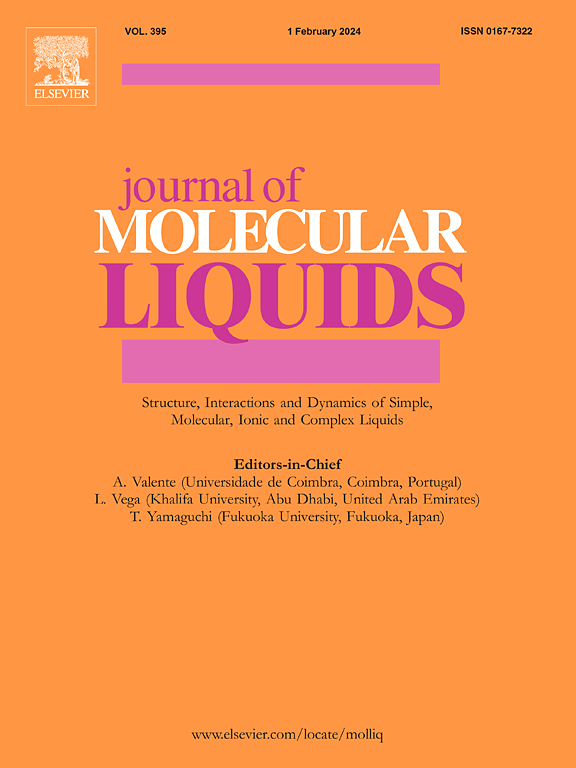Doxorubicin removal from an aqueous environment efficiently using bimetallic organic frameworks: Synthesis, characterization, and optimization of adsorption procedure using the Box–Behnken design
IF 5.2
2区 化学
Q2 CHEMISTRY, PHYSICAL
引用次数: 0
Abstract
A solvothermal approach was utilized to successfully synthesize the La/Cs metal–organic frameworks (La/Cs-MOF). The synthesis was confirmed by means of evaluations of surface area, point of zero charge (PZC), powder X-ray diffraction (PXRD), field emission scanning electron microscopy (FESEM), transmission electron microscope (TEM), and X-ray photoelectron spectroscopy (XPS). The La/Cs-MOF material stands out for having a significant pore volume (6.64 cm3/g) and surface area (1662.2 m2/g). Surprisingly, we discovered that the adsorption behavior is significantly affected by changes in the solution’s pH. At pH 6 and with a dosage of 0.02 g, we found the ideal settings to obtain a high adsorption capacity. The adsorption development is endothermic, meaning that as temperatures rise, so does the capacity. The La/Cs-MOF was used to remove aqueous solutions containing hazardous organic pollutants, such as doxorubicin hydrochloride (DOX). The adsorption process was fitted to Langmuir isothermally and kinetically fitted to pseudo-second-order. It was revealed that a chemisorption mechanism was involved throughout the entire development. Box–Behnken design (BBD) and Response Surface Methodology (RSM) were used to improve the solution pH, absorbent dosage, time, and temperature. For DOX, the values of (ΔH°), (ΔS°), and (ΔG°) were effectively obtained. These calculations showed that the reaction was both endothermic and spontaneous when using La/Cs-MOF as an adsorbent. It was found that the maximum adsorption ability was 962.6 mg/g. A number of possible mechanisms, including hydrogen bonding, π–π bonding, pore-filling, electrostatic interactions, and chemisorption, have been proposed as part of the La/Cs-MOF adsorption mechanism for the dye DOX.

利用双金属有机框架高效去除水环境中的多柔比星:合成、表征以及使用 Box-Behnken 设计优化吸附程序
利用溶热法成功合成了 La/Cs 金属有机框架(La/Cs-MOF)。通过评估表面积、零电荷点 (PZC)、粉末 X 射线衍射 (PXRD)、场发射扫描电子显微镜 (FESEM)、透射电子显微镜 (TEM) 和 X 射线光电子能谱 (XPS) 确认了合成结果。La/Cs-MOF 材料具有显著的孔隙体积(6.64 立方厘米/克)和表面积(1662.2 平方米/克)。令人惊讶的是,我们发现溶液 pH 值的变化对吸附行为有显著影响。在 pH 值为 6、用量为 0.02 克时,我们发现了获得高吸附容量的理想设置。吸附的发展是内热式的,这意味着随着温度的升高,吸附容量也会升高。La/Cs-MOF 被用于去除含有盐酸多柔比星(DOX)等有害有机污染物的水溶液。吸附过程与 Langmuir 等温线拟合,与假二阶动力学拟合。结果表明,化学吸附机制参与了整个吸附过程。采用盒-贝肯设计(BBD)和响应面方法(RSM)对溶液 pH 值、吸附剂用量、时间和温度进行了改进。对于 DOX 来说,(ΔH°)、(ΔS°) 和 (ΔG°) 的值都得到了有效的计算。这些计算结果表明,使用 La/Cs-MOF 作为吸附剂时,反应既是内生的,也是自发的。研究发现,最大吸附能力为 962.6 mg/g。La/Cs-MOF 对染料 DOX 的吸附机理有多种可能,包括氢键、π-π 键、孔隙填充、静电作用和化学吸附。
本文章由计算机程序翻译,如有差异,请以英文原文为准。
求助全文
约1分钟内获得全文
求助全文
来源期刊

Journal of Molecular Liquids
化学-物理:原子、分子和化学物理
CiteScore
10.30
自引率
16.70%
发文量
2597
审稿时长
78 days
期刊介绍:
The journal includes papers in the following areas:
– Simple organic liquids and mixtures
– Ionic liquids
– Surfactant solutions (including micelles and vesicles) and liquid interfaces
– Colloidal solutions and nanoparticles
– Thermotropic and lyotropic liquid crystals
– Ferrofluids
– Water, aqueous solutions and other hydrogen-bonded liquids
– Lubricants, polymer solutions and melts
– Molten metals and salts
– Phase transitions and critical phenomena in liquids and confined fluids
– Self assembly in complex liquids.– Biomolecules in solution
The emphasis is on the molecular (or microscopic) understanding of particular liquids or liquid systems, especially concerning structure, dynamics and intermolecular forces. The experimental techniques used may include:
– Conventional spectroscopy (mid-IR and far-IR, Raman, NMR, etc.)
– Non-linear optics and time resolved spectroscopy (psec, fsec, asec, ISRS, etc.)
– Light scattering (Rayleigh, Brillouin, PCS, etc.)
– Dielectric relaxation
– X-ray and neutron scattering and diffraction.
Experimental studies, computer simulations (MD or MC) and analytical theory will be considered for publication; papers just reporting experimental results that do not contribute to the understanding of the fundamentals of molecular and ionic liquids will not be accepted. Only papers of a non-routine nature and advancing the field will be considered for publication.
 求助内容:
求助内容: 应助结果提醒方式:
应助结果提醒方式:


